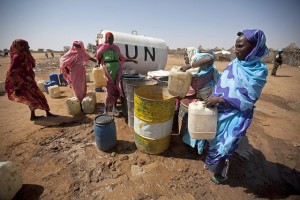BY BIANCA GIRAULT: The United Nations eight Millennium Development Goals (MDGs) were established to address the most pressing needs of the world’s poorest population by 2015. Despite the United Nations efforts to Ensure Environmental Sustainability globally (Goal #7), their efforts to improve access to water and sanitation have not sufficiently reached both rural and urban communities equally. The seventh MDG goal aims to halve the portion of the population without access to safe drinking water and basic sanitation. Rural communities continue to grow without adequate water and sanitation resources. However, the more rapid expansion of urban communities proves that national governments, financial institutions and international organizations should justly allocate water and sanitation efforts as they look to the future of both rural and urban communities.
There is disproportionate access to water and sanitation resources due to economic disparities in developing countries. A large percentage of wealthier individuals live in urban areas, where it is easier to obtain essential resources to enhance water and sanitation provision. According to the “United Nations Millennium Development Goals and Beyond 2015â€, 97% of poorer populations do not have access to piped water supplies and 14% drink unsafe surface water. Furthermore, humanitarian assistance from NGOs and international aid organizations is largely seen in urban areas. This forces members of rural communities to alter their way of life in order to obtain the benefits of international aid. For example, UNICEF reported in March 2012 that 71% of women and girls are tasked with the responsibility of carrying water to their rural villages in Sub-Saharan Africa. Thus, members of rural communities are further disadvantaged from social opportunities, such as education or employment, due to their respective geographic location.
The United Nations data on water and sanitation from the MDG initiatives is also not holistically representative of the challenges, progress (or lack thereof) in developing countries. The MDGs global statistics on water and sanitation do not holistically reveal the outcomes of the United Nations work towards sustainable development in rural and urban areas. According to the World Bank, 2.5 billion people currently do not have adequate sanitation facilities. Many of these people live in rural communities or slums in developing countries that are further removed from access to water and sanitation services. In March 2012, UNICEF revealed in a press release, that nations with improved access to water located in Latin America and the Caribbean (17%) and North Africa (9%) have rural dwellers that resort to open defecation. Therefore, because rural dwellers are challenged by water and sanitation access there use of environmentally threatening practices continue to challenge countries overall efforts.
The rapid urban growth of populations in developing countries has also created a challenge to water and sanitation aid. According to the United Nations Department of Economic and Social Affairs (UNDESA), there are two main challenges related to water that influence the sustainability of human urban settlements: 1) the lack of access to safe water and 2) sanitation and increasingly water-related disasters such as floods and droughts. For example, in Dakar, Senegal, a city highly vulnerable to floods, stagnant water remained after annual floods, resulting in health complications, such as malaria and cholera. Despite the increase in water and sanitation improvements in urban cities since 1990, the fluctuation of the global urban population counters these efforts. Moreover, UNDESA reported that although 1,865 million urban dwellers obtained improved drinking water and sanitation, the urban population had increased by 1,089 million people between 1990 and 2008. Therefore, the population continued to grow at rate that was inconsistent with the water and sanitation resources allocated for urban dwellers.
The MDGs’ long-term success and living conditions in urban as well as rural communities ultimately relies on the accessibility of water and sanitation systems. Global institutions and non-governmental organizations have traditionally created reconstruction and subsidy programs to improve access to water and sanitation after floods and droughts in capital cities. However, because members of rural communities live in remote locations they are unable to receive these resources. Moreover, the rapid growth of urban areas hinders improved access to water and sanitation. Improvement initiatives should be modified to resolve specific challenges, such as the spread of diseases, viruses and practice of open defecation, in rural and urban communities. People living in these communities should be included in the planning process and equipped with the necessary skills to maintain such systems. Through improved processes and citizen empowerment, rural and urban communities will gradually transform into more liveable areas, despite environmental challenges. United Nations MDG reports have demonstrated the improvement of access to water and sanitation resources across nations. However, in actuality water and sanitation support within countries still has much progress to make. Through the collaborative support of UN agencies and non-governmental organizations sustainable resources can be implemented to support the water and sanitation access in rural and urban communities.





